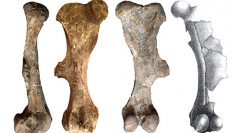

 Geodiversitas
38 (4) - Pages 579-594
Geodiversitas
38 (4) - Pages 579-594Croizet & Jobert (1828) described as Rhinoceros elatus a large rhinoceros from the late Pliocene deposits of the Puy-de-Dôme District (Auvergne, France). In the following century and a half, the species had been sporadically recognized and its name had been almost forgotten. Guérin (1972) described as Dicerorhinus jeanvireti the remains of the same species from the locality of Vialette (Haute-Loire, France), pretending that “elatus” was a nomen oblitum. After that, the name “jeanvireti” was used by most of the following authors. At present, there is general agreement in the literature that the two names are synonyms but some authors prefer “elatus” while others use “jeanvireti”, thus leading to increasing confusion. The present investigation reveals that “elatus” deserves the right of priority because in 1972 it was not a nomen oblitum. The younger synonym “jeanvireti”, according to the rules of the International Code of Zoological Nomenclature, cannot be considered a valid name. Furthermore, most of the rhinoceros remains described by Croizet & Jobert (1828), namely the syntypes of the species, are still existing and are housed at the Muséum national d’Histoire naturelle in Paris. Since this material has never been described in detail after Croizet & Jobert’s work, it is revised in modern key and compared to close fossil species. Among this material, an articulated anterior leg is hereby designated as lectotype of the species Stephanorhinus elatus Croizet & Jobert, 1828.
Nomenclatur, Etouaires, lectotypification.